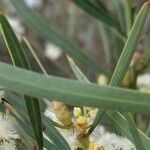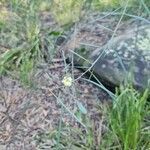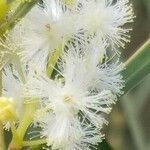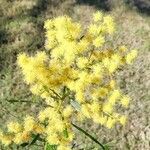A straggly evergreen shrub. It grows to 2 m high and spreads to 2 m across. The stem is erect and slender. The small branches are sharply angular. They form a spreading open branched shrub. The leaves (phyllodes) are bluish grey and narrow. They have a single vein and are thickened at the edge. They are 5-14 cm long by 0.3-1 cm wide. They can be slightly curved. They are narrowed towards the base. The flowers are pale yellow balls. They are sweetly perfumed. They occur in long narrow clusters. A leaf like structure (bract) occurs near the flower buds but falls off early. The pods are long and flat. They can be 3-4 cm long by 1.5 cm across. They are purplish brown. The edges are thickened. There are about 6 seeds in a pod.
Unarmed slender little-branched shrub to 2.5 m high. Branchlets angular, glabrous, sometimes glaucous. Phyllodes coriaceous, glabrous, straight or slighdy curved, acute or obtuse, mucronate, (6-) 7.5-12.5 by (0.2-)0.3-0.7(-l) cm, (9-)13-27 (-35) times as long as wide, with a small gland at or within 4 mm of the base, pulvinus 1-2 mm. Flowering heads composed of 3-7 flowers, grouped in glabrous axillary racemes. Flowers whitish green, (4-)5-merous, bisexual. Pod with a striking blue-black colour, glabrous, glaucous, oblong, obtuse, apiculate, flat but raised over the seeds, 2.5-4 by 1.3-1.7 cm. Seeds transverse, 6-7 by 3-4.5 mm, pleurogram closed; funicle 3-folded and thickened in a slighdy oblique, basal aril.




